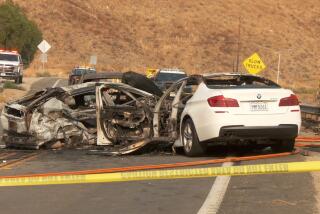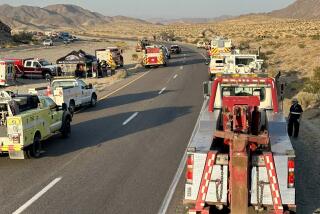More Crashes Attributed to Permit Errors
At least 14 accidents involving oversized trucks misrouted by Caltrans have occurred so far this year, double the number that state officials have previously admitted, according to a report released Tuesday.
The California Highway Patrol discovered the additional accidents after supervisors asked officers to recall any crashes caused when too-high trucks attempted to pass under low-lying bridges. Further research by the CHP confirmed that the routes taken by the oversized trucks had been erroneously approved by the California Department of Transportation’s permitting office.
The new data mark the third time state officials have amended upward the number of accidents caused by bad permits--accidents that killed an Orange County man and caused tens of thousands of dollars in property damage.
The study was commissioned at the request of Sens. Joe Dunn (D-Santa Ana) and Betty Karnette (D-Long Beach) and released at a public hearing on the issue held Tuesday in Downey.
Dunn said the latest revelations are shocking and expressed little confidence that Caltrans can prevent other permitting mistakes in the future.
“The problems are more extensive, and it’s going to take a lot longer to fix than I felt we were led to believe,” he said. “I thought we were on the verge of a fix, and instead we are a year or two away. This is a public safety issue.”
Dunn said he was also troubled by testimony Tuesday by two Caltrans permit writers, who described a far more antiquated system for issuing permits than Caltrans officials have portrayed. They also indicated that additional accidents had occurred, including some that involved overly wide trucks.
“As we’re talking, another 400 to 500 permits are being written today,” testified Joe Weber, a permit writer who filed a union grievance over working conditions at the office. “Ask yourself when you leave here [and see] an oversized truck if you want to be driving near it.”
The troubled truck permitting operation has been under intense scrutiny since a Westminster man was killed July 16 when a truck he was traveling behind hit an overpass and lost its load.
The accident occurred after a permit writer working overtime failed to note that the truck’s stated 15-foot load could not pass under the 14-foot-10-inch bridge on the transition between the Riverside and Orange freeways in Anaheim.
An accident report obtained by The Times indicates that the truck’s load was 5 inches higher than even the permit allowed. The report also said that only five straps held the load in place--half the number required by the permit. CHP investigators questioned whether the truck’s load would have fallen off had all 10 straps been used.
The truck’s driver told authorities he believed his load was under 15 feet in height--the minimum clearance through the middle of the overpass. Still, he admitted to investigators that he had not measured the load himself.
Tam Trong Tran, 36, was crushed to death when the 7,000-pound fiberglass fuel tank the truck was hauling slammed into the bridge and toppled onto his car.
Caltrans officials at first said the accident was an isolated event, one of only three such mistakes made in the previous 3 1/2 years.
The latest tally brought the total number of known permitting errors during that period to 33. One of the newly reported accidents occurred in Orange County, on the San Diego Freeway at Warner Avenue last December. Details of the accidents were not available, but like almost all the others, no one was reported killed or injured.
A permit is required for any truck wider than 8 1/2 feet, longer than 40 feet, heavier than 4 tons or higher than 14 feet.
The economic boom in recent years has also created a boom in oversized truck traffic, a 44% increase in the last six years, while staffing in the Caltrans permitting office has increased by only 17%.
In their testimony before the state subcommittee, the two permit writers raised concerns about Caltrans’ efforts to fix the problems.
Rick Hill, who supervises the San Bernardino permit operation, one of two offices in the state, said that a computer database used to check the safety of proposed routes is only about 60% complete. It is considered only a tool in writing permits, along with manual maps and routing information, not the antidote for human error that Caltrans promised, he said.
Hill also raised the issue of other permitting errors that have not been scrutinized, citing an example of a mobile home that was wedged on a ramp connecting the Santa Ana and Costa Mesa freeways last year after construction overseers failed to notify his office of the installation of a concrete barrier.
The 20-year veteran of the permitting office expressed doubts about the feasibility of any “fail-safe” computerized system that might be acquired.
Such a system--one that would make it impossible to issue a permit when known problems exist along the route--has been promised by Caltrans Director Jose Medina in letters to the Senate Transportation Committee.
The earliest a fully automated system could be purchased and put in place would be the end of next year, said Hossein Rostam, who was recently brought in to revamp the permitting operation.
* TUSSLE OVER WELDS
Caltrans is refusing to provide welds to a Senate panel probing safety of the Orange Crush. B1
(BEGIN TEXT OF INFOBOX / INFOGRAPHIC)
More Permit Errors
*
The California Highway Patrol has identified seven more cases of trucks hitting bridges as a result of permit inaccuracy this year, for a total of 14. The sites:
*
Sources: California Highway Patrol, Caltrans
More to Read
Sign up for Essential California
The most important California stories and recommendations in your inbox every morning.
You may occasionally receive promotional content from the Los Angeles Times.










